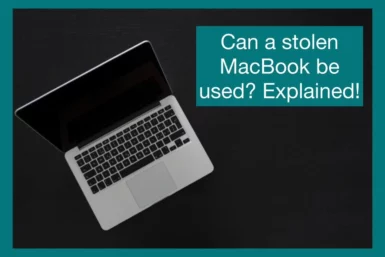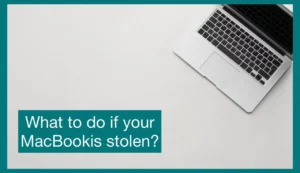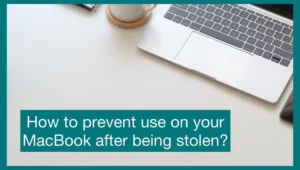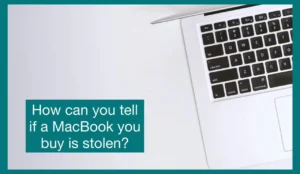It can be hard to know what can happen if you are unlucky enough to have your MacBook stolen. Would it still work, or will it cause problems for both the thief and unwitting users? Will the thief be able to use it and what can he do with your logged in accounts? It can be frustrating not knowing, but don’t worry!
In this article, we will explain what to do when your MacBook is stolen and all of the things that a thief can do once he/she has your MacBook. We will also explain how you can avoid buying a stolen MacBook, along with other necessary information you need to know.
Can a Stolen MacBook Be Used?
There are significant ethical and legal issues with using a stolen MacBook. Even while it might still work, using stolen devices can have serious consequences for both the thief and the unintentional user.
Understanding the possible risks and the significance of ethical decisions in the linked world of today requires a thorough examination of the consequences of such actions.
What to Do If Your MacBook is Stolen?
Taking quick, responsible action is essential if you experience the tragic event of having your MacBook stolen to improve the likelihood of recovery and safeguard your sensitive data.
You should try to locate your MacBook using its built-in utilities and any available third-party software as one of your initial actions.
1. Find My Mac
If you’ve turned on the “Find My Mac” function on your MacBook, you can use it to locate the device. Use the Find My app on your iPhone or iPad to use the feature, or use iCloud on another Apple device.
Once enabled, you can examine the MacBook’s last known position, remotely lock it, show a personalized message on the screen, or even start a full data erasure to protect your privacy.
2. Police Report
Report the theft right away to your local law enforcement agency. Give them all pertinent information, including the MacBook’s serial number and any identifying characteristics. A police report on file may be useful for legal and insurance claims.
3. Apple Support
Contact Apple Support and let them know about the theft. They can help you blacklist the stolen MacBook, making it more difficult for the thief to use or sell the computer.
4. Community Forums and Social Media
Inform people about the stolen MacBook in the appropriate community forums and social media sites. There is a rare possibility that someone will find your device being sold or offered online, which could result in its retrieval.
5. Third-Party Tracking Software
Consider employing third-party tracking software if you want to prevent theft. Some programs come with further capabilities, including taking pictures of the thief using the MacBook’s camera, taking screenshots, or recording keystrokes to provide proof to law enforcement.
6. Surveillance Cameras
If the theft occurred in a public area, see if there were any nearby surveillance cameras. This information should be reported to the police to help them locate the thief.
Remember that your safety is crucial, so refrain from going against the robber alone. Cooperate with police enforcement instead, giving them any pertinent information they could require for the inquiry.
How to Prevent the Theif from Using Your MacBook After Being Stolen?
You must secure your stolen MacBook from unauthorized use to protect your private information and privacy. Even though no approach is failsafe, taking the following precautions can considerably lower the likelihood that your stolen MacBook will be used for nefarious purposes:
1. Find My Mac
Ensure your MacBook’s “Find My Mac” feature is turned on before using the remote lock and erase feature. You can execute a full data cleanse or remotely lock the device in the event of theft to stop unauthorized access to your private data.
2. Strong Password and Biometrics
To secure your MacBook, use a strong, one-of-a-kind password. To add a layer of security, consider enabling biometric authentication options like Touch ID or Face ID.
3. Two-factor authentication.
Enable two-factor authentication (2FA) for your Apple ID and any other important accounts connected to your MacBook. Even if they know your password, thieves will have a harder time accessing your accounts as a result.
4. FileVault
Turn on FileVault, macOS’s built-in disc encryption tool, to encrypt data. This ensures that your data is secure and inaccessible without the proper login information.
5. Regular Backups
Use Time Machine or cloud-based backup services to often back up your MacBook. By doing this, you may make sure that even if your MacBook is stolen, you won’t lose any important data and can restore it to another device.
6. Avoid Auto-Login
Turn off the MacBook’s auto-login function. If auto-login is deactivated, the thief will require your password to access your user account.
7. Remove Private Information
Don’t keep private information locally on your MacBook. To keep important files safe, use external encrypted discs or online storage.
8. Log In with Your MacBook
Keep track of your MacBook’s model, serial number, and other identifying details. To help with recovery efforts, register the device with Apple and any applicable authorities.
How Can You Tell if A Macbook You Buy is Stolen?
To keep moral standards, avoiding transactions with stolen goods is imperative because buying a stolen MacBook might have major legal repercussions.
In addition to aiding criminal activity, buying a stolen MacBook subjects you to liability for having stolen property in your hands. Here are some methods you can take to determine its legality so that you don’t unintentionally purchase a stolen MacBook:
1. Examine the Serial Number
Before purchasing, ask the seller for the MacBook’s serial number. To find out if the gadget has been reported stolen, check the serial number on the Apple website or support service.
2. Examine the Device for Modifications
Check the MacBook for any physical alterations or indications of tampering. Serial numbers on stolen gadgets may be altered, scraped out, or erased to hide where they came from.
3. Ask for Valid Proof of Purchase or Ownership
Request valid proof of purchase or ownership from the seller, such as the original package or receipt. Genuine vendors ought to be able to offer this data.
Plan to meet the seller at a public location, such as a coffee shop or police station, to complete the transaction. This increases security and deters fraudulent transactions.
4. Check the Price
If the MacBook is being offered for a price that seems unusually cheap in relation to its market value, be wary. Deals that look too good to be true can indicate stolen merchandise.
5. Sign Out of iCloud
Ask the seller to sign out of their iCloud account in front of you to make sure the MacBook is not activation locked. A device that requires activation may have been stolen.
6. Use Renowned Platforms
When shopping online, stick to renowned markets and platforms that offer buyer protection. If there are any problems with the purchase, these platforms can be helpful.
7. Ask for The Original Packing
Reliable dealers frequently have the MacBook’s original packing and accessories. The device might be stolen if the merchant doesn’t have these things.
How a Theif Can Use Your Stolen MacBook?
The thief can use your macbook for various different things that may be legal or illegal. Some of them are:
- If the thief is savvy, they may be able to get into your account and start using your MacBook right away. They will have access to all of your files, passwords, and contacts- so make sure you are always keeping track of your device!If you have any sensitive information on there, it’s best to change your passwords and contact information right away.
- MacBooks are a hot commodity on the black market, and thieves know this. They may try to sell your device to someone who will use it themselves, or they may try to break it down for parts. Either way, your data is at risk. Make sure you have a good anti-theft program installed on your device so that you can track it if it does end up getting stolen.
- If the thief has your password, they may be able to get into your iCloud account and access all of your files. This can include anything from contacts to financial information. If you have any sensitive data on your device, make sure you are using two-factor authentication to keep your account safe.
- If your MacBook is stolen by a hacker or other cybercriminal, they may be able to install keylogging software on the device that will give them access to all of your personal information as you type it in- including passwords and credit card numbers!
How to Protect Your MacBook from Being Stolen?
These are the methods you can try to avoid being stolen:
1. Use a Good Anti-Theft Program
There are a number of different anti-theft programs that can help you track your device if it is stolen. Programs like Find my iPhone and Prey allow you to see where your device is, lock it, or even delete all of the data on it if it’s in danger.
2. Use a Passcode
It may seem like an inconvenience to have your device locked, but it can really help prevent thieves from getting into things easily and quickly. Make sure you set up a strong password that is hard to guess for any other device as well!
3. Don’t Leave Personal Information
When you are not using your MacBook, make sure you are keeping all of your private information safe. This means removing anything from the device that could be used to access your iCloud account or get into other services- including accounts for email and social media!
4. Install Tracking Software
If something does end up happening to your MacBook or smartphone, having GPS-based tracking software installed can help you find it again. Make sure you are picking the right software for your device and that it is set up to save battery life!
5. Physical Security
Use your MacBook cautiously in public areas, and never leave it alone in exposed locations.
Conclusion
In conclusion, managing a stolen MacBook necessitates caution and accountability. Safeguarding with tracking features, robust security protocols, and backups is crucial.
However, you should never buy a stolen MacBook because doing so encourages crime and has serious legal ramifications. To prevent theft and create a safer online environment for everyone, always emphasize moral decisions and cooperate with law authorities.




